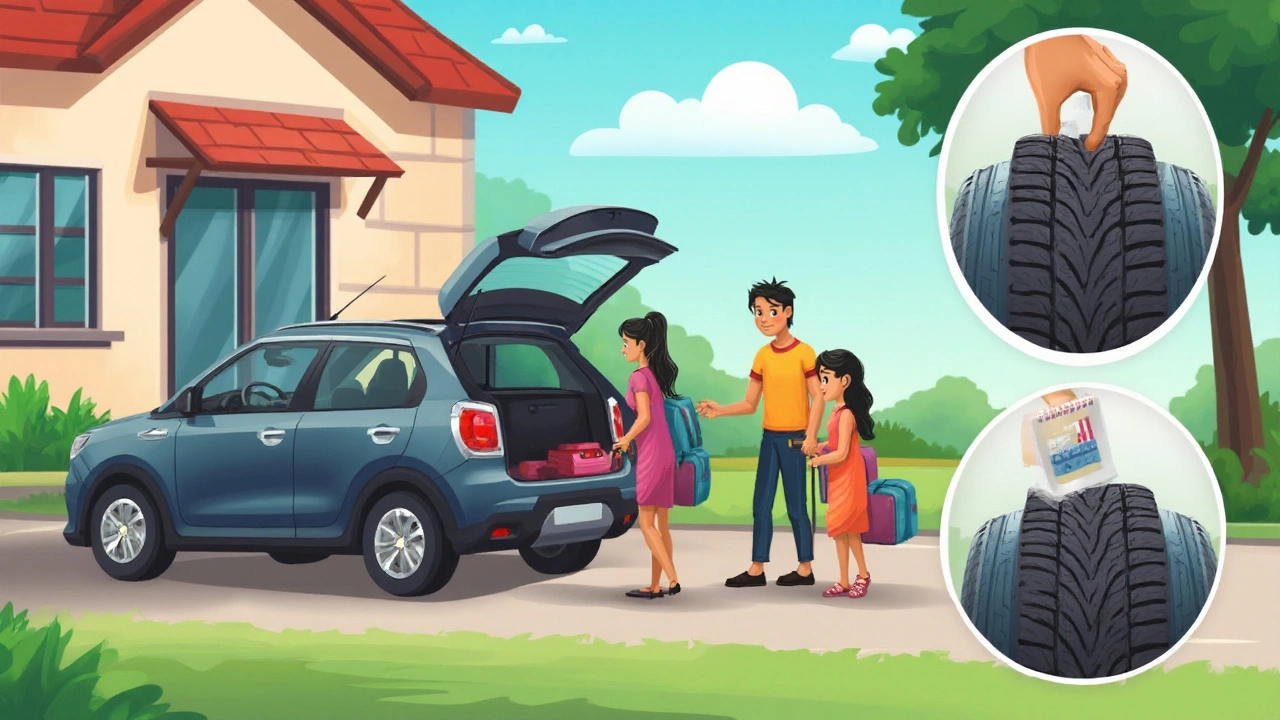 Aug, 5 2025
Aug, 5 2025
Imagine suddenly blowing a tire on the QEW at rush hour. Not fun. Most drivers wait for a flat before ever thinking about changing their tires. But tires are the only thing between you and the pavement. They're not invincible. Every week, somewhere in Canada, someone crashes because their tires were overdue for retirement. So, how long can you actually trust those old rubbers on your car—and what clues tell you it's time for a new set?
Why Tire Replacement Isn’t Just About Tread
Tread depth grabs the headlines, but there’s more to tire life than just how much rubber is left. Heat, UV rays, road salt, hauling big loads and even where you park all play a role in tire aging. In fact, even if you leave your car parked in a garage for years, the tires are still aging. The rubber slowly dries out, causing cracking, hardening or “dry rot.”
Car makers like Ford and Toyota usually recommend replacing tires every six years regardless of tread, and tire companies like Michelin say never go longer than ten years. That’s why even if your tires look okay, the calendar matters just as much as any ruler.
Tires in Hamilton get unique abuse: big temperature swings, brine salts, freeze-thaw potholes, and lots of city stop-and-go. These things age tires fast and differently than someone driving dry Arizona highways.
Let’s look at the main things that limit your tires’ lifespan besides simply miles:
- Ozone and sunlight: They break down the oils in tire rubber, especially sidewalls.
- Road chemicals: Winter brine and summer grime dry out and crack rubber prematurely.
- Driving habits: Hard stops, sharp corners, loaded trunks—these all eat away at your tread faster.
- Poor maintenance: Low air pressure, skipped rotations, improper alignments—each can cut tire life in half.
Some stats bring things into focus. The Rubber Association of Canada says the average Canadian tire lasts 3 to 7 years—usually closer to the lower end in urban Ontario. Short city trips, climate, and rough roads matter way more than most people think.
| Tire Type | Average Lifespan (years) | Typical Warranty (km) |
|---|---|---|
| All-season | 3-6 | 70,000 - 100,000 |
| Winter | 3-5 | 50,000 - 80,000 |
| Performance/Summer | 2-4 | 30,000 - 60,000 |
| All-terrain (SUV/Truck) | 4-7 | 80,000 - 120,000 |
How Long Do Tires Really Last?
The biggest question: should you trust manufacturer promises, mileage numbers, or what? Start with a realistic range. Most Canadian drivers can expect four to six years out of their tires, assuming about 20,000 to 24,000 km each year. Winter tires wear out faster, especially if left on during warm months or run on dry pavement. Summer performance tires, built for grip, need changing even sooner.
Here's something you might not realize: the rubber mix, how deep the tread starts, and even the climate you drive in all change that basic lifespan. For example, tires from the U.S. or made for southern climates often don’t handle Canadian extremes as well as homegrown brands like Goodyear or Michelin—the compounds just aren’t as frost-resistant.
City driving is tough on tires, too. Start-stop traffic, sudden potholes, and road debris lead to more frequent damage. If you’re commuting around Hamilton’s industrial areas or neighbourhoods with lots of construction, keep an even closer eye out.
Still, large surveys by tire retailers show two-thirds of tire replacements happened due to wear, but a third happened because of cracks, bulges or age—meaning external tread wasn’t always the main culprit. That points to the importance of regular checks, not just mileage.
Look for the tire's date code: on the sidewall, there's a 4-digit number after the letters "DOT." For example, “2219” means the tire was made in the 22nd week of 2019. If that number says five-plus years ago, start planning for a replacement, no matter how deep the tread looks.

Warning Signs Your Tires Need Changing
Waiting for a blowout is not a great replacement plan. Instead, spot the trouble before you’re stranded. Here’s what you should be checking—not just every few months, but ideally every few tankfuls or before a road trip. You don’t need to be a mechanic to spot most of these things:
- Bald or very shallow tread: You need at least 1.6 mm (2/32”) of tread—use a toonie or a tread gauge. If the silver rim shows, it’s time.
- Cracks or spiderweb patterns: These mean the rubber is hardening and can’t grip or flex safely.
- Bulges or blisters: These weak spots signal the tire’s inner structure is failing, upping the risk of a dangerous blowout.
- Vibration or wobbling: If your steering wheel shakes at speed, the tire may be worn unevenly or have a hidden internal problem.
- Punctures or cuts: Even a slow leak can be a bigger problem beneath the surface, weakening the tire from the inside out.
- Tire age over six years: No visible damage? Still replace at this point, per car maker and tire company advice.
Note that Canadian law mandates minimum tread depth for safety: 1.6 mm for summer/all-seasons, but most pros recommend swapping them out at 3 mm (4/32”), as wet stopping distances shoot up when you get below that number. For winter, don't let your tread get below 4.8 mm (6/32”). Below that, your tires can't bite into snow and slush and your ability to stop nosedives.
One more big warning: run-flat or self-sealing tires can sometimes hide sidewall damage. Don’t assume you’re safe just because the tire didn’t go fully flat.
How to Make Your Tires Last Longer
You can stretch out that lifespan—sometimes by years—with some easy habits. Here’s where a few minutes every month save hundreds of dollars and a lot of headaches:
- Check air pressure monthly: Under-inflated or over-inflated tires wear out unevenly or overheat and break down faster. Most Canadian cars call for about 32–35 PSI. Cold snaps can drop pressure, so keep a gauge handy.
- Rotate tires every 10,000–12,000 km: This evens out wear, since front tires take more abuse (steering and engine weight)
- Get alignments annually: If you bounce through a big pothole—get an alignment check. Misaligned tires scrub against the pavement and wear faster.
- Clean off winter salt: Road salt eats away at the rubber, causing premature cracking. A quick rinse on warmer days does wonders.
- Store tires correctly: If you swap between winter and all-seasons, store the spare set on their sides in a cool, dark area—not out in the sun or stacked for months.
- Fix suspension issues right away: If your shock absorbers or bushings are toast, your tires bounce around, not roll smoothly. Extra pounding shortens tire life by thousands of kilometres.
Keep receipts and check your warranty—sometimes, you can get partial credit towards new tires if wear occurs earlier than promised, but only if you’ve got proof of proper rotations and maintenance. Shops in Hamilton get tire warranty claims several times a week, but few people actually keep the records needed to claim it.
Don’t forget: sudden changes in how your car handles (noisy turns, pulling to one side, sudden dips in fuel economy) often link straight back to tire issues. Stay alert to those little clues—your car’s telling you something isn’t right beneath the wheel wells.

The Real Dangers of Waiting Too Long
It’s tempting to squeeze a bit more life out of tired tires. But let's talk stakes. Worn tires need up to double the stopping distance in rain or snow. Hydroplaning risk shoots up, especially if the tread is below 4/32”. Insurance companies in Ontario track accidents with worn or improperly maintained tires, and those claims get flagged. If your tires are beyond wear limits, insurance might actually deny your claim after a collision.
It doesn't stop at fender-benders, either. The Ontario Provincial Police report dozens of highway closures every winter due to tire blowouts or vehicles sliding on bald tires. Specialized crash studies in 2024 found that 1 in 10 winter weather accidents could be traced back to tires that had no business being on the road anymore.
Even in dry weather, the differences are huge. According to a test by CAA, stopping from 50 km/h with new all-seasons takes 31 metres; with worn ones, it jumps to 51 metres. That's the difference between avoiding a fender-bender and being in the middle of one.
The cost of waiting too long is often more than just money. Let’s say you avoid a $600 tire replacement by driving another six months—one blown out tire or slide into a curb, and you’re suddenly on the hook for thousands in repairs or more. And if your vehicle has any kind of safety system (ABS, traction control, lane-keeping assist), worn tires make all that tech useless, because the only thing touching the road is slippery rubber.
Lately, Hamilton’s seen a jump in drivers turning to used or online tires as a quick fix, especially with prices high post-pandemic. Be extra careful when buying used—always check that DOT date and look for repairs on the inside. Older or patched tires can look fine but hide stress fractures and puncture damage that’s just waiting for a bump to become a blowout.
Bottom line: never roll the dice with old or questionable tires. Your car’s tires are a cheap insurance policy for everything else you value.